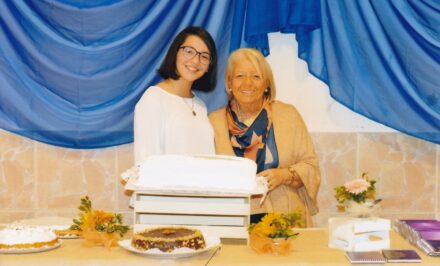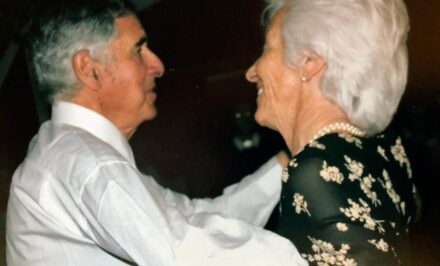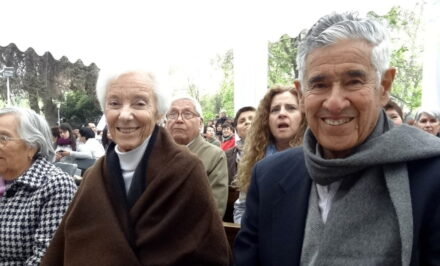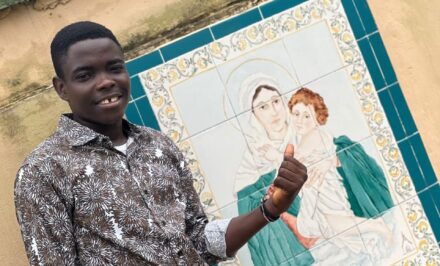 mda. At the age of 92, and still on the threshold of Schoenstatt’s new century, Fr Rudolf Mosbach was called to his eternal home on 6 November 2014. With his clear view of Fr Kentenich’s basic principles, on which Schoenstatt has to continue to be built in the future, and as a result of his many and varied pastoral tasks in the Schoenstatt Movement, especially as the Spiritual Assistant to the Institute of Schoenstatt Families, he has become a point of orientation and fatherly guide to many generations.
mda. At the age of 92, and still on the threshold of Schoenstatt’s new century, Fr Rudolf Mosbach was called to his eternal home on 6 November 2014. With his clear view of Fr Kentenich’s basic principles, on which Schoenstatt has to continue to be built in the future, and as a result of his many and varied pastoral tasks in the Schoenstatt Movement, especially as the Spiritual Assistant to the Institute of Schoenstatt Families, he has become a point of orientation and fatherly guide to many generations.
![]()
 Is the “October Week” an institution that transcends time; can two generations with different attitudes to life and forms of expression exist in a section of the Movement, or should they be separated; what is the role of statutes; who may do what, and what is possible in the Movement, and what is not? – Fr Rudolf Mosbach never had a settled solution in his pocket, or a custom-made answer; instead he offered principles, fundamentals, counsels, and the almost infinite calm and “quiet gaiety” of a person who has weathered countless storms. This helped him to navigate his way surely through the immediate storm he was facing, and passed over to the questioning, concerned or excited person who was asking for his advice.
Is the “October Week” an institution that transcends time; can two generations with different attitudes to life and forms of expression exist in a section of the Movement, or should they be separated; what is the role of statutes; who may do what, and what is possible in the Movement, and what is not? – Fr Rudolf Mosbach never had a settled solution in his pocket, or a custom-made answer; instead he offered principles, fundamentals, counsels, and the almost infinite calm and “quiet gaiety” of a person who has weathered countless storms. This helped him to navigate his way surely through the immediate storm he was facing, and passed over to the questioning, concerned or excited person who was asking for his advice.
On 6 November, as his obituary testifies, after he had witnessed Schoenstatt’s Jubilee celebrations with a clear mind and many questions, he stepped over the threshold into eternity. At the end of November, when Holy Mass is offered in the Original Shrine for all who have died in this Jubilee Year, his name will also be mentioned.
Priestly activity in the Schoenstatt Movement
In his obituary, Fr Theo Breitinger wrote:
In May 1943, during a furlough from the front, he was accepted as a Novice into the Pallottine Society in the Original Shrine at Schoenstatt, and began an “extern Novitiate” that was officially continued in Olpe, Westphalia in 1945 after his release from POW camp. On 11 October 1947 his Novitiate ended with his acceptance into the Pallottine Society (SAC – Societas Apostolatus Catholici) through his first Profession. He did his philosophical and theological studies at first in Olpe (1946-1947), then in Vallendar-Schoenstatt (1947-1949), and finally at the Papal Gregorian University in Rome (1949-1952). He was ordained a deacon on 24 March 1951 in Rome, and to the priesthood on 1 July 1951 by Archbishop Luigi Traglia at the altar of St Vincent Pallotti in the church of San Salvatore in Onda in Rome.
His priestly activity was carried out mainly in the Schoenstatt Movement. After the completion of his studies, he took over duties in the Pilgrimage Movement at the shrine in Schoenstatt from 1952-1956. In the summer of 1956, as a result of the tensions that had meanwhile arisen between Schoenstatt and the Pallottines, he was no longer allowed to work in Schoenstatt and was transferred to Mulheim, Ruhr, where he worked as a teacher of religion in a vocational college, and youth chaplain, until 1959. In December 1959 he was appointed prison chaplain in Frankfurt, Main, and worked there until 1966.
After the return of Fr Kentenich, the Founder, from exile in the USA, it again became possible for Fr Mosbach to work in the Schoenstatt Movement from July 1966: In the Mothers’ Movement (1966-1981); in the Schoenstatt Mothers’ Federation (until 1990), and in the League for Academics (1969-1983). In January 1976 he became Spiritual Assistant to the Institute of Schoenstatt Families until 1998. With the completion of his 75th year all official appointments came to an end. As far as possible he continued to work in the League for Professional Women.”
 Ver Sacrum, Holy Springtime
Ver Sacrum, Holy Springtime
“In the dangerous period of National Socialism (Nazi) and the Second World War he grew into the so-called “Ver Sacrum” (Holy Springtime) generation, which consciously took its bearings from Schoenstatt’s founder generation in the time of World War I: their believing attachment to the Blessed Mother and the shrine, their commitment and readiness for sacrifice in the service of a great mission for the Church and society.
The sanctuary lamp symbol of the “Ver Sacrum”, which the Schoenstatt Young Men put up in the Original Shrine in New Year’s night 1940/41, became the expression of the vigilant responsibility of this generation for the place of foundation and Schoenstatt’s source of life, and for its mission.
Through his education and his work Fr Mosbach developed a deep attachment to the two founders – Vincent Pallotti and Fr Kentenich. From them he received clear guidance and manifold help for his own way in life. He placed himself and his entire priestly life totally at the disposal of their mission and the work that proceeded from it.
The years he spent in Rome gave him above all a personal attachment to Vincent Pallotti, as well as an orientation in faith to his mission and its realisation through Schoenstatt.
His work in Schoenstatt led him to a profound attachment to Fr Kentenich, both as a person and in his spirituality, which included his task in life and his Schoenstatt Family. This brought him in 1954 to the “Treuekreis” (Loyal Circle) that formed around our Founder in exile. As a result, he was drawn directly into the controversies at that time about the Leitbild (guiding principle; mission statement) and the autonomy of the Schoenstatt Family as distinct from the Pallottine Society, as well as the newly founded community of Schoenstatt Fathers. Together with many confreres in the Pallottine Society, Fr Mosbach was eventually able to join this new community of Schoenstatt Fathers, and on 18 October 1966 he placed his perpetual contract with that community into the hands of the Founder. The members of the “Ver Sacrum” generation gave their re-founded course the name “Patris Ver Sacrum” – the Holy Springtime of the Father.
Fr Mosbach remarked repeatedly that it was a special gift of Divine Providence that in 1966, immediately after the return of the Founder from exile, he was able to place himself directly at his disposal for his work in Schoenstatt. In the same way, after Fr Kentenich’s death he strove to perpetuate his spiritual intimacy with him, to lead many to a personal attachment to the Founder, to make his spirituality known, and to continue serving the entire Schoenstatt Movement in this spirit.”
You will be my witnesses to the ends of the earth
“You will be my witnesses to the ends of this earth, you will be my witnesses, because I uphold you …” These words form the refrain of a hymn presented to Fr Mosbach by the Professional Women on the occasion of his Golden Jubilee of priesthood. It was not only a successful variation of the quotation on his Ordination Card, but also a guiding theme of the celebration of the Schoenstatt Movement on 8 July – the anniversary of Fr Kentenich’s ordination – with Fr Mosbach. We read in a report of 2001, “This man is blessing, because he thinks of anything else but himself’, as Fr Tilmann Beller, at that time Leader of the Schoenstatt Movement in Germany, put it in his sermon, and went on to say, “This man started to think of other things than himself. The childish egotism, which can so often be found in religious circles, had no place in his presence. If someone thinks of something else than himself, he is a blessing who shows goodwill to others. And if someone thinks of something else than himself, he is never offended.”
Requiem: Wednesday, 12 November 2014, 2 p.m. in the Church of the Blessed Trinity on Mount Schoenstatt, followed by his burial in the cemetery of the Schoenstatt Fathers on Mount Sion.
Letters of condolence: Schoenstatt Fathers, Fr Theo Breitinger, Sion 6, 56179 Vallendar-Schoenstatt, breitinger@schoenstatt-patres.de













